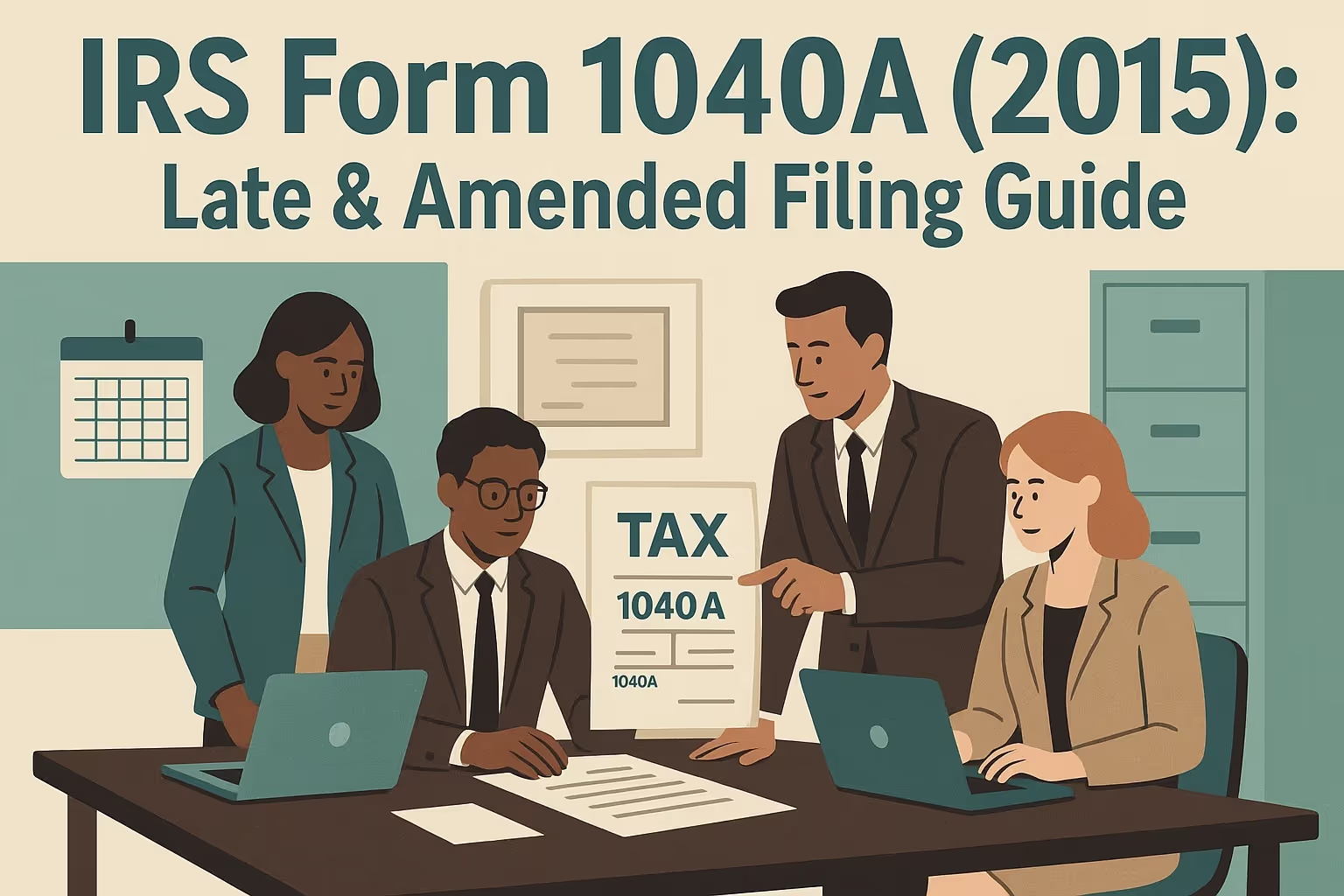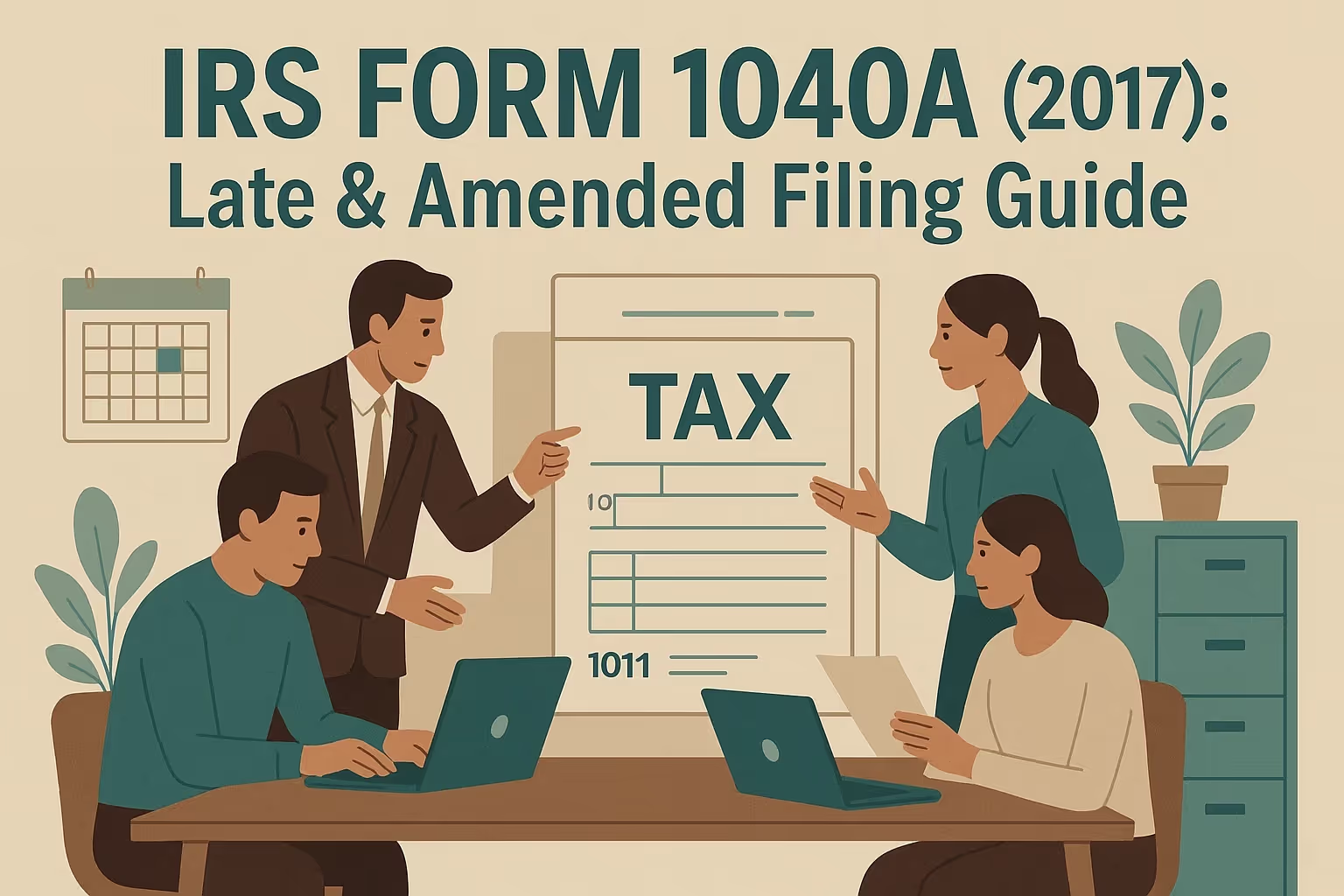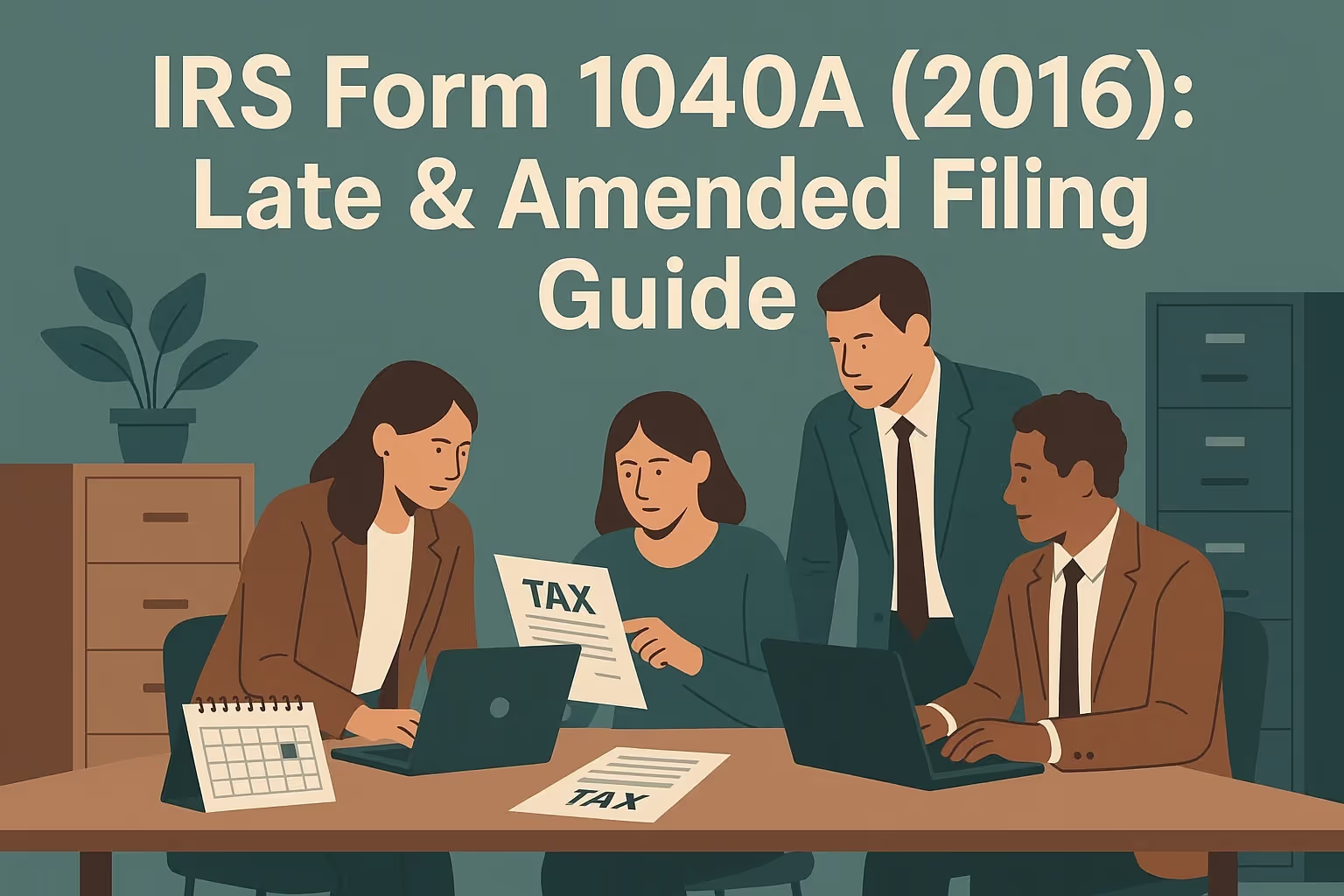IRS Form 1040A (2015): Late & Amended Filing Guide

What IRS Form 1040A (2015) Is For
IRS Form 1040A (2015) was a simplified U.S. individual income tax return used by taxpayers with basic income and limited deductions. This short form applies to individuals with taxable income of under $100,000 who have wages, interest, dividends, capital gain distributions, pension income, unemployment compensation, or Social Security benefits. It could also include withholding or estimated taxes paid during the year.
You would use this income tax return if you needed to file a prior year form to stay in compliance, request relief from enforcement actions, or meet requirements for loan or program applications. According to IRS files, Form 1040A applied to individual taxpayers who did not need to report business returns or other taxes beyond the basic income tax requirements.
For a detailed breakdown of filing requirements, eligibility rules, and updates for this version, see our Form 1040A (2015) Instructions and Individual Taxpayer’s Guide.
When You’d Use Form 1040A for 2015 (Late or Amended Filing)
You should file a late or past due return using Form 1040A (2015) if you received IRS notices about missing returns, owe back taxes, or must establish compliance. Common notices include CP59 (unfiled return), CP501 (balance due), or other reminders about failure to file.
A taxpayer might also need to file a claim for a refund before the statute of limitations expires in April 2019. If you fail to file or pay on time, penalties and interest will apply. The 2015 form must be used specifically for that tax year since tax law and instructions change annually.
Key Rules Specific to the 2015 Tax Year
The 2015 tax year required individuals to report health insurance coverage or pay a shared responsibility charge. You had to indicate qualifying health coverage on line 38, claim an exemption using Form 8965, or pay the penalty.
The due date for 2015 returns was April 18, 2016, due to the Emancipation Day holiday in Washington, D.C. If you missed this date, your refund claim and credits were limited by statute. The IRS may assess interest or initiate enforcement actions for unpaid balances.
You could not electronically file the 2015 form; it must be sent by paper mail. Always use the IRS address listed in the 2015 instructions and keep proof of delivery. This helps if you later need to verify filing status or request an account transcript.
Step-by-Step (High Level)
- Gather transcripts: Request Wage & Income Transcripts and Account Transcripts from IRS.gov or by calling 800-908-9946. These IRS files display the reported income, withholding, and payments for 2015.
- Complete the 2015 Form 1040A: Use only the 2015 version found under “Prior Year Forms” on IRS.gov. Follow the 2015 instructions carefully, as the form layout and deductions differ from those in later years.
- Attach required schedules: Include Schedule B for interest/dividends over $1,500, Form 8965 for health coverage exemptions, and Form 8962 if you received premium tax credits. Verify your information and totals before mailing.
- Mail the return: Because you cannot electronically file a prior year return, print and send your completed Form 1040A to the correct IRS address. Certified mail or tracking is recommended. Keep a paper copy and digital backup on your device.
- Keep records: Maintain copies of all forms, schedules, and correspondence. These documents may be required if you need to request relief, file an amended return, or respond to future notices.
Common Mistakes and How to Avoid Them
- Using the wrong year’s form: Always prepare the correct 2015 version of Form 1040A. Do not use newer versions or different forms for other taxes.
- Missing SSNs or ITINs: Ensure all individual taxpayer identification numbers are accurate. Incomplete information may cause refund delays or penalties.
- Incorrect withholding data: Verify wages and withholding amounts using IRS Wage & Income Transcripts.
- Forgetting health coverage information: Line 38 must show whether you had coverage or an exemption.
- Mathematical errors: Review your calculations. The IRS may automatically correct math errors, but this could adjust your balance due or refund.
- Filing status errors: Selecting the incorrect status can impact deductions and credits. Double-check before submission. If you are a business owner, be mindful of common business tax problems related to deductions and credits.
What Happens After You File
The IRS usually takes six to eight weeks to process a 2015 tax return on paper. During busy periods, processing time may extend to 16 weeks. You can check your refund status or account online using a secure portal marked by a locked padlock icon.
If you owe taxes, you will receive a balance due notice showing penalties, interest, and payment options. You can pay online, set up an installment agreement using Form 9465, or apply for an extension to pay if necessary. If you fail to pay, enforcement actions or criminal prosecution may follow in rare cases.
If you disagree with an IRS adjustment, you can request an appeal as explained in IRS Publication 5. Interest continues to accrue from the original due date until the full amount is paid.
FAQs
Can I still get a refund for 2015?
Generally, no. The statute of limitations for claiming a refund expired in April 2019. However, if you qualify under exceptions such as disability, military service, or disaster relief, you may apply for consideration. Filing still helps maintain compliance and avoid additional enforcement actions.
What penalties will I owe for filing my 2015 return late?
Penalties include a failure-to-file charge of 5% per month (up to 25%) and a failure-to-pay charge of 0.5% per month. Interest is assessed daily. These apply from the due date until payment is received. You can request relief or an installment plan if you are facing financial hardship.
Do I also need to file a state return?
Most states require a corresponding state return if you file a federal return. Some states also offer separate relief programs or payment plans for past due returns. Always visit your state tax agency website for current instructions and deadlines.
Can I e-file a 2015 return now?
No, the IRS system has only allowed electronic filing in recent years. Past returns, such as Form 1040A (2015), must be sent by paper. Always include the correct mailing address and keep your certified mail receipt.
What if I don’t have my 2015 W-2 or income forms?
You can request Wage & Income Transcripts from the IRS to find your reported wages and withholding. This helps ensure your return is complete and accurate. Never estimate income or deductions without supporting information.
Should I hire a tax professional?
Professional assistance is helpful if you have multiple notices, penalties, or missing information. Tax software may help you prepare basic returns, but professionals can help assess penalties, apply for relief programs, or respond to enforcement actions.
What if I never filed and don’t owe taxes?
If you had no filing requirement and no taxes owed, the IRS generally won’t assess penalties. However, filing a prior year return can protect you if IRS files show unreported income or if you later apply for credits or refunds.
Learn more about Form 1040A and other simplified individual returns to better understand late or amended filing options.


























